Modules
Model building
Semi GeoBase
This module contains basic functionality for importing, editing and quality checking the geological model.
The functionality in the GeoBase module includes:
- Define stratigraphic model and edit lithologies
- Decompaction modelling using mixed lithologies, erosion events and palaeowaterdepth histories.
- Quality control of depth model (Crossing horizons etc.)
- Import of subsidence histories from other software (PetroMod, 3DMove etc)
- Powerful map editing tools, including logical and mathemetical operations, digitizing, interpolation/extrapolation etc.
- Import and conversion of maps, fault traces, fault planes, well logs etc. in industry standard formats.
- Construction of Fault Cases for use in fluid flow simulations.
- Construct basemap (coastlines, blocks/quadrants, fields, prospects, well locations etc.)
- Basic visualisation capabilities (Map view and profiles)
Semi Palaeowater
Published...
Hydrocarbon generation
Semi Source
The Semi Source module allows the users to perform fast and reliable map-based modelling of maturation of organic matter and expulsion from the source rock. A library of oil/gas/vitrinite kinetic models for typical source rock types is included with the software, but user-defined kinetic models may also be applied.
Temperature histories are typically supplied as maps of geothermal gradient or absolute temperatures through time.
Two main expulsion models are available for oil/gas systems models: The Pepper & Corvi (1995) adsorption model and the Skjervøy & Sylta (1993) saturation-based model.
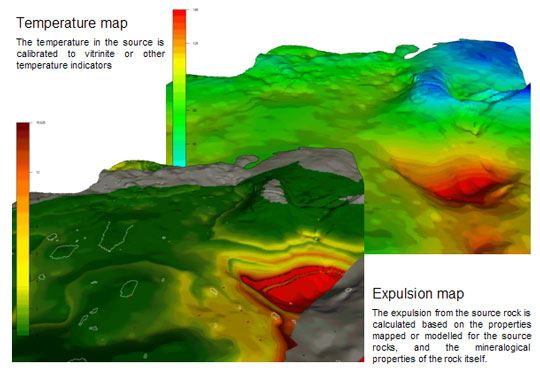
Semi MC Generation
The amount and composition of the petroleum expelled from a source rock typically differ greatly from those of the petroleum generated within this rock. For example, coal may generate oil but expel only gas. This effect occurs because certain petroleum components are retained in the source rock. These may be cracked and expelled when the source rock reaches higher temperatures. We have developed a process-based expulsion model which assumes
- that kerogen behaves like a polymer and is able to dissolve organic compound in its structure (Polymer solution theory), and
- that some macerals contain nanopores (with radii of around 1 nm) and that molecules "caught" in these pores behave according to the physical laws pertaining there (Dubinin-Radushkevitch theory).
The multicomponent expulsion moule in Semi can use either standard multicomponent kinetic models or models coming from the multicomponent kinetics tool KING.
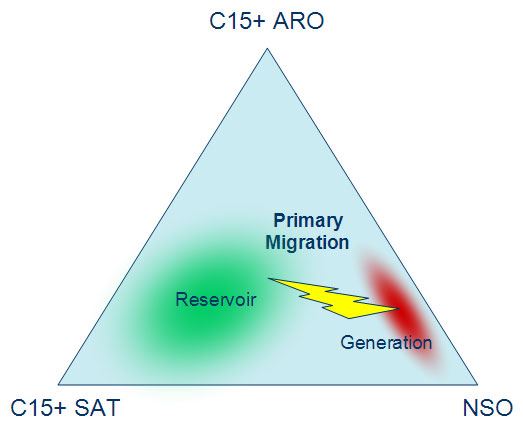
Fractionation trends during primary muigration.
Hydrocarbon charge
Semi Migration
Semi has extensive capabilities for simulating secondary migration and entrapment of oil and gas. The functionality in the Semi migration module includes:
- Model migration of oil and gas along a carrier bed through time. The carrier bed may change during burial, causing creation and/or destruction of traps.
- Model spill of oil and/or gas from traps through time
- Compute cap rock sealing and leakage with capillary leakage or hydraulic leakage
- Compute cracking of oil to gas in traps
- Model secondary migration losses of hydrocarbons during secondary migration
- Deviate migration and trapping because of cross-fault sealing, juxtaposition geometric or clay smear faults
- Account for barriers caused by carrier bed pinch-outs and salt domes
- Let hydrocarbons leak vertically from a deeper reservoir into a shallower one
- Account for gas densities, GOR, CGR and oil densities in traps during subsidence as functions of pressure and temperature
- Compute volumes of oil and gas trapped in prospects within a basin
- Pass information from regional simulation runs to detailed runs (windowing)
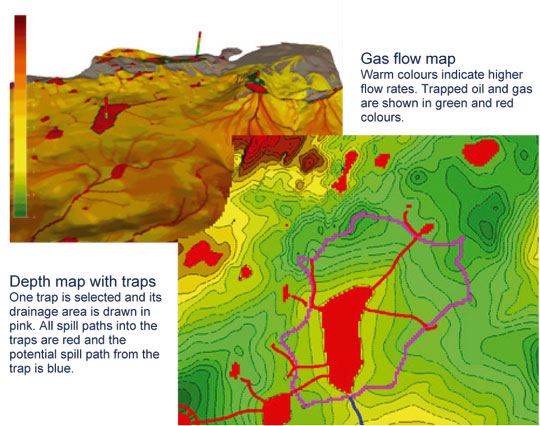
Examples of migration modelling results; gas flow, accumulations,drainage areas and spill paths.
Semi MC Migration
This module includes functionality for tracing the composition of the migrating hydrocarbons in terms of single components or compound groups. A multicomponent phase behavoiur model is used to compute the phase distribution and physical properties at varying P-T conditions.
The PVT and phase behaviour model used by Semi is based on cubic equations of state for describing fluid behaviour and the following options are available
- Peng-Robinson (Peng & Robinson 1976)
- Soave-Redlich-Kwong (Soave 1972)
- Generalized Redlich-Kwong
The library has a built-in data bank containing critical properties and binary interaction parameters for 19 selected components. Other components or compound groups may be used if the appropriate data are specified by the user.
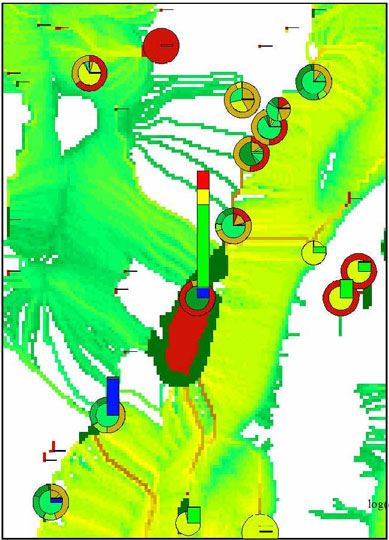
Oilflow map with multicomponent composition plotted for the traps. The innermost circle represents the composition (as mole fractions) in the liquid phase and the outermost circle shows the composition in the vapour phase.
Semi Fault Seal
One of the main mechanisms for generating fault seal is by shale smearing of shaley gouge fomration in fault zones. Fault sealing potential in clastic sequences is related to the percentage of shale within the part of the sequence that has moved past a point on the fault surface, termed the Shale Gouge Ratio (SGR).
A method for incorporating the effects of fault seal due to presence of shaley fault gouge has been implemented in the Semi Fault Seal module. The development of this software was done as a part of the INFAMI EU project in cooperation with Fault Analysis Group at UCD Dublin and Århus University.
The construction of SGR fault seal models in Semi is done in three steps:
- Construct a 3D Lithology model from available vshale well logs and avaiable depth horizones
- Calculate SGR values on fault surface and convert to fault rock entry pressures
- Convert to potential trapped column heights for different fluid properties (hydrocarbon densities)
References:
Sylta, Childs, Moriya, Walsh, Manzocchi, 2000. A method for including the capillary properties of faults in hydrocarbon migration models. Presented at the NPF Hydrocarbon Seal Quantification conference, October 2000. PDF (1757 kB)
C. Childs, Ø. Sylta, S. Moriya, D. Hermansen, J. Strand & J.J. Walsh, 2002. Incorporation of fault seal capacity into hydrocarbon migration modelling of Oseberg-Syd, Viking Graben. AAPG Hedberg meeting"Evaluating the Hydrocarbon Sealing Potential of Faults and Caprocks", December 2-5, 2002, Barossa Valley, South Australia: Abstract & presentation (4.2 MB PDF).
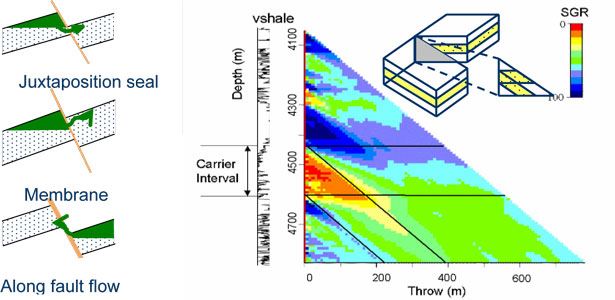
Semi Biodegradation
A modelling tool for predicting risk of encountering biodegraded oil in undrilled prospects has been designed and built into the basin modelling simulator SEMI. The Semi-BD simulator accounts for mixing of biodegraded and fresh oils during migration and filling of reservoirs and predicts the physical properties of the trapped biodegraded oil.
Semi-BD assumes that biodegradation occurs within a relatively thin zone above the oil/water contact (OWC), as suggested by observations of compositional gradients in biodegrading oilfields (e.g. Larter et al. 2003, Huang et al. 2004). The field-wide biodegradation rate is therefore influenced by the ratio between the OWC area and the oil volume. Semi can treat the oil column as compositionally uniform (i.e. assume instant homogenisation within the reservoir) or mimic vertical compositional variations using a diffusion-based approach.
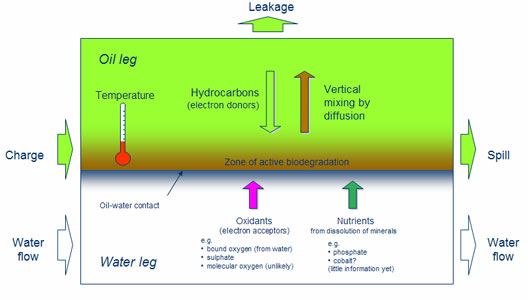
Pressure modelling
Pressim
The fluid pressure distribution in a carrier or reservoir rock can influence the secondary migration of petroleum in a sedimentary basin. Good estimates of present fluid pressure in yet undrilled prospects are highly relevant for planning safe well layouts and drilling procedures.
Modelling of the fluid pressure distribution over geological periods of time and up to present day can therefore contribute to reduce explorational and technical risks.
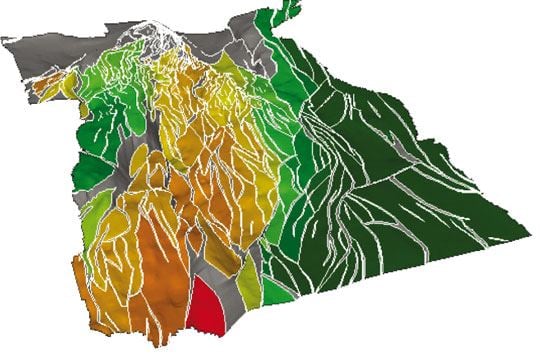
Fluid pressure in carrier rocks is generated within pressure cells which are typically bounded by (wholly or partly sealing) faults and low-permeable cap rocks.
Within these cells, pressure can be generated by compaction and chemical diagenesis. It can be dissipated by lateral flow across faults and by vertical leakage through the caprock.
The Pressim module defines the reservoir units into pressure compartments and perform pressure generation within and dissipation between the pressure compartments. The 3D flow pattern on a geological time scale and the resulting pressure distribution are modelled. It is thus possible to achieve a best calibrated case out of a large number of simulations that may form a basis for uncertainty and sensitivity analyses.
Pressim has been successfully applied to numerous case studies on different types of basins. Pressim pressure simulation tools may be integrated to the most common basin modelling tools.
Contact: Ansattinfo mangler
Pressim Drilling
The multi-purpose pressure modelling tool Pressim includes the processes most relevant to pressure generation and dissipation. It is thus possible to make pressure and flow predictions along a planned well path. This make unique application to drilling possible:
- pressure forecast and update during drilling
- drilling in depleted reservoirs
- avoiding drilling hazards
- optimised well placement
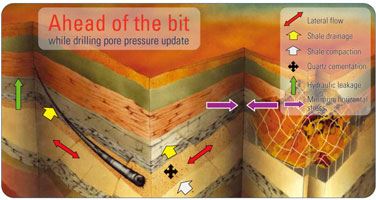
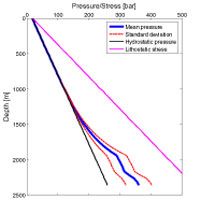
Pressim Production
The calibrated flow models from basin modelling studies have shown that the pressure within the reservoir units is a dynamic phenomenon on a geological time scale. If the pressure difference across the lateral barriers is increased (i.e. due to pressure depletion from production) the pressure may even behave dynamically on a production time scale. Pressure communication between adjacent fields in production have been observed all over the world in different types of sedimentary basins.
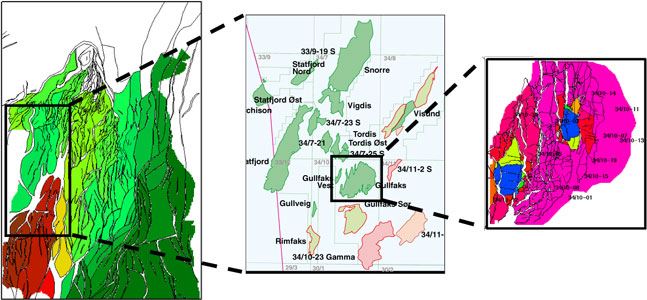
Overpressure modelling at different scales
It is possible to model the pressure communication within a petroleum province using the Pressim tool. The calibrated flow across the boundary can be adopted from a basin modelling pressure study. This technique offers several applications:
- Natural pressure support from surrounding aquifers
- Pressure communication between adjacent fields
- Pressure optimization for petroleum provinces
- Boundary conditions for reservoir simulations
Risk evaluation
Semi MOCA
The SEMI secondary migration simulator is deterministic, while the results we aim to construct are sometimes statistical in nature (e.g. statistical distributions). A simple method by which deterministic models can be made to yield statistical results is, of course, to put the deterministic model inside a Monte-Carlo simulation procedure. This requires that one is able to adjust the variables of the deterministic model for each randomly selected input value specified by the Monte-Carlo simulation procedure and to store the results for later processing.
The SEMI MOCA approach starts with an established hydrocarbon generation model for the area. This model contains oil and gas generation maps for a series of source rock units. For each simulation run, important input parameters are selected randomly and usually independently. The more variables one adjusts, the more simulations may have to be run to build reliable probability distributions from the simulation results. There is, in principle, no maximum limit to the number of parameters that can be varied in such a procedure.
For each migration simulation run, results for all traps (calibration fields and prospects) are stored. After storing the results, the iterative procedure is repeated until enough simulations have been run.
The probability distributions of trapped oil, solution gas and free gas can now be built from all the stored simulation results. One important aspect in our set-up is that the simulation results can be weighted according to how well they match the discoveries that have been made in the area. This kind of weighting can only be performed when secondary migration modelling is performed, because this is the only way to directly link the computed hydrocarbon volumes of different traps, e.g. the amount of oil in one trap is directly linked to the volume of gas in another trap in a single simulation run.